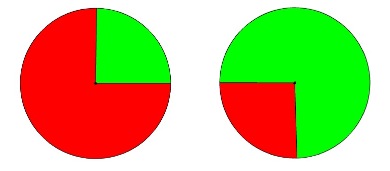Copyright © University of Cambridge. All rights reserved.
Turning
Well, let's have a look at doing some simple turning.
To have a go at this task, you'll first need to make this 'interactivity' out of two differently-coloured discs of thick paper or card. Cut a slit into each from the edge to the centre in a straight line. Overlap the two slots and turn them to link the two discs together:
This YouTube Video shows how to make a similar thing with paper plates.
Can you turn your discs to show what:
a) a book being opened looks like from above?
b) turning a volume knob on your music player looks like?
c) a bicycle wheel looks like when going along?
d) a door would look like from above as it's being opened?
e) what a hamster wheel looks like when the hamster's running inside it?
Describe and then show some other things that you do or have seen, that turn in this way.
You can also have challenges that are just to do with the picture you see, for example, can you make the turning shape appear on the other side?

Can you make the red part twice the size of the green?
Have fun! You're experiencing Angles - the way turning is measured.
Why do this problem?
This
investigation allows children to experiment with turning - they would not need any prior experience to have a go at the activities. The cardboard tool will help pupils develop the concept of turning and can be used before moving on to angle work.
Possible approach
Show the class a ready-made 'interactivity' by manipulating it as they watch, talking through what you are doing. Depending on the class' age and experience, help them make the tool themselves, or give out some you have already made.
You might want to continue by encouraging children to visualise one of the scenarios. Can someone use their tool to show the turning they had been imagining? Invite the rest of the group to comment and refine the motion accordingly. You could then actually find the item and do what is described to see how accurate the interactivity was.
Children could then work in pairs, either at a computer, or with the card version. Encourage them to talk to each other as they try out their ideas.
Key questions
Tell me about what you are imagining.
How could we "check" what you have done?
Possible extension
Children could demonstrate a turn and challenge other children to select what it represents from, for example, a list of three scenarios.
Possible support
Some children will need to 'copy' the turning action of an item with their tool before they are confident at visualising.

